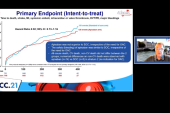Subclinical Thrombosis After TAVI Benign, at Least to 3 Years
Leaflet thickening on CT was linked to more hemodynamic valve deterioration, highlighting the need for further study.

The early presence of subclinical thrombosis after transcatheter aortic valve implantation does not result in an increased risk of death in mid-term follow-up, nor does it lead to an increased risk of cerebrovascular events, according to results from a new study.
Symptomatic hemodynamic valve deterioration was more common in patients with hypoattenuated leaflet thickening (HALT) identified on CT angiography, but the rate of bioprosthetic valve failure did not differ between patients with and without HALT, report investigators.
“The results of our study regarding mortality and cerebrovascular events confirm a benign clinical course of HALT, whereas the long-term consequences of HALT with respect to valve durability may play a clinical role at least in some patients,” lead investigator Manuel Hein, MD (University Heart Center, Freiburg-Bad Krozingen, Germany), and colleagues write in a paper published June 6, 2022, in JACC: Cardiovascular Interventions.
Importantly, the researchers say the findings support current clinical guidelines that state oral anticoagulation after TAVI should be avoided unless it is needed for another clinical indication. “Symptomatic hemodynamic valve deterioration remains a rare event, even in the subset with early HALT,” they state.
Ole De Backer, MD, PhD (Rigshospitalet/Copenhagen University Hospital, Denmark), who led the GALILEO-4D substudy investigating reduced leaflet motion (RLM) after TAVI, commended the researchers, noting that they have a lot of experience studying subclinical thrombosis after TAVI. While the study helps shed light on the clinical implications of HALT and RLM, there are limitations to what the research can show, he said, pointing out that the follow-up is relatively short at a little more than 3 years and the study size insufficient.
“We absolutely need larger trials to study this,” De Backer told TCTMD. “We need trials that have not just CT at a single time point but consecutive CT follow-up in these patients. It’s not enough to have one CT scan—in this particular study the CT scan was very done early—because we need to know what happens with HALT over time. Does it become worse? Does it disappear? We need good, systematic studies, with larger number of patients, with systematic CT and longer follow-up. Only then will we have the final answer, say in 5 to 10 years from now.”
Nonetheless, the present study is the “best we have for now,” he commented.
Clinical Relevance of CT Findings
For many years now, researchers have been trying to determine the clinical relevance of subclinical valve thrombosis documented on CT. Red flags were raised back in 2015 when Raj Makkar, MD (Cedars-Sinai Medical Center, Los Angeles, CA), published pooled data from RESOLVE and SAVORY, as well as an analysis from the PORTICO-IDE study, showing evidence of leaflet thickening in patients who underwent TAVI.
Since then, researchers have attempted to determine if HALT was a benign imaging finding or if it led to adverse clinical outcomes. There was also considerable debate as to whether clinicians should treat patients with oral anticoagulation after TAVI to prevent HALT and RLM or to use anticoagulation once it was detected.
Several clinical trials, including GALILEO and ATLANTIS, showed that oral anticoagulation could reduce subclinical thrombosis, but its use did not reduce the risk of adverse clinical outcomes. In fact, the GALILEO trial showed that a rivaroxaban-based strategy in TAVI-treated patients increased the risk of death, thromboembolic complications, and bleeding compared with an antiplatelet-based treatment strategy.
We absolutely need larger trials to study this. We need trials that have not just CT at a single time point but consecutive CT follow-up in these patients. Ole De Backer
In the present study, Hein and colleagues wanted to determine the long-term prognostic impact of HALT detected early after TAVI with a range of transcatheter heart valves. Using data from their prospective, observational registry, they diagnosed HALT in 115 (16.0%) of 804 patients who underwent CT angiography a median of 5 days after the procedure. Of these, 17 patients were excluded because they had an established indication for anticoagulation. All patients included in the analysis were treated with DAPT for 6 months after TAVI, followed by single antiplatelet therapy.
After a median follow-up of 3.25 years, there was no significant difference in the risk of all-cause mortality in patients with and without HALT. The 3-year estimates for survival were 70.1% and 74.0% in patients with and without HALT, respectively (P = 0.597). Additionally, there was no significant difference in the risk of cardiovascular mortality. The 3-year event rate for cerebrovascular events was 2.0% in patients with HALT and 4.4% in those without subclinical thrombosis (P = 0.246).
The Kaplan-Meier 3-year estimate for hemodynamic valve deterioration, which was defined according to the Valve Academic Research Consortium-2 recommendations (at least a 10-mm Hg increase in the mean gradient or a mean gradient ≥ 20 mm Hg with new-onset dyspnea, aggravation of dyspnea, or new-onset angina pectoris without progression of coronary heart disease), was 9.4% in patients with HALT versus 1.5% in those without (P < 0.001). Bioprosthetic valve failure occurred in 2.6% of patients with HALT and 1.2% of those without HALT, a difference that was not statistically significant (P = 0.121).
To TCTMD, De Backer said that while the study seems quite large at more than 800 patients, there were just 10 patients with symptomatic hemodynamic valve deterioration following the development of HALT, which is quite small and further underscores the need for larger studies. Moreover, other studies investigating the implications of HALT and RLM have typically scanned patients at 30 to 90 days after TAVI, as opposed to the 5-day CTs in this analysis.
“It’s a very early screening for this phenomenon,” he said. “What we know about [HALT] is that it’s a dynamic phenomenon, which can come and go. On the one hand, the early screening is a strength of the study, but on the other it’s an Achilles’ heel. We don’t know what happens to HALT later on in the patients who have it.”
Overall, the majority (78.6%) of patients in the study were treated with SAPIEN 3/XT transcatheter valves (Edwards Lifesciences), 16% were treated with the self-expanding CoreValve Evolut R/PRO (Medtronic), and 5.3% were treated with a mix of valve types. For that reason, De Backer stressed caution about extrapolating these results to all valve types, noting that most received a balloon-expandable valve.
Do Not Start on Oral Anticoagulation
The researchers say the present study hasn’t led to any changes in their antithrombotic strategy after TAVI. Moreover, it affirms that systematic oral anticoagulation is “likely not justified” given the similar clinical outcomes between those with and without HALT.
In light of the increased risk of subsequent hemodynamic valve deterioration in patients with subclinical valve thrombosis, they suggest that CT after TAVI might be warranted in select patients, namely those in whom echocardiographic abnormalities are detected during follow-up. If necessary, oral anticoagulation can reverse the progressive increase valve gradients caused by HALT, they speculate.
De Backer agreed that oral anticoagulation is not warranted in patients where HALT or RLM is identified on CT angiography.
“Just keep these patients on the antithrombotic therapy they are on, which is usually just single antiplatelet therapy,” he said. “The only thing you might consider is closer follow-up of these patients and to really be aware that they need yearly echocardiographic follow-up. If there is further worsening of the transvalvular gradients, or these patients become symptomatic due to HALT or leaflet thickening—where it becomes clinically relevant—then it might be possible start oral anticoagulation.”
Lars Søndergaard, MD, DMSc (Rigshospitalet/University of Copenhagen), who wrote an editorial accompanying the study, notes that while oral anticoagulation might prevent or resolve HALT, its use is associated with higher mortality in elderly and frail patients. He also points out that subclinical leaflet thrombosis may progress or resolve over time without any change in antithrombotic therapy, which makes it difficult to conclude that evidence of HALT at discharge is responsible for bioprosthetic valve failure years later.
“Studies with an extended systematic follow-up regarding hemodynamic valve performance are desirable to investigate the influence of HALT on long-term durability of bioprosthetic aortic valves,” he writes.
The Nordic Aortic Valve Intervention Trial 4 (NORDIC-4) should help provide some information on the use of medications in this area, as researchers are randomizing 600 patients to different antithrombotic strategies after TAVI and following them for 5 years. That study will include clinical assessments, CT, and echocardiography at multiple time points, with additional imaging in patients with thromboembolic events or signs of valve deterioration.
Søndergaard also stresses that routine use of CT to check for subclinical leaflet thrombosis should not be performed outside of research settings. Such imaging, he writes, exposes patients to needless radiation and contrast when there is no evidence that a positive finding of HALT would justify use of oral anticoagulation.
Michael O’Riordan is the Managing Editor for TCTMD. He completed his undergraduate degrees at Queen’s University in Kingston, ON, and…
Read Full BioSources
Hein M, Schoechlin S, Schulz U, et al. Long-term follow-up of hypoattenuated leaflet thickening after transcatheter aortic valve replacement. J Am Coll Cardiol Intv. 2022;15:1113-1122.
Søndergaard L. Does subclinical leaflet thrombosis impact the durability of bioprosthetic valves? J Am Coll Cardiol Intv. 2022;15:1123-1125.
Disclosures
- Hein and Søndergaard report no conflicts of interest.
- De Backer previously reported institutional research grants and consulting fees from Abbott and Boston Scientific.





Comments